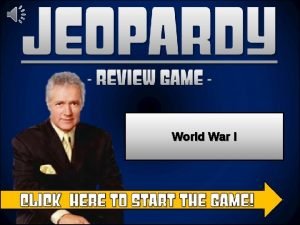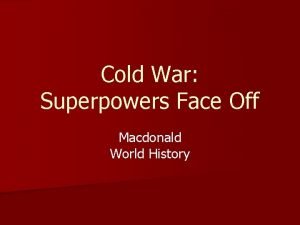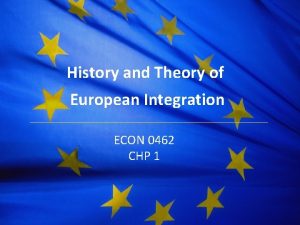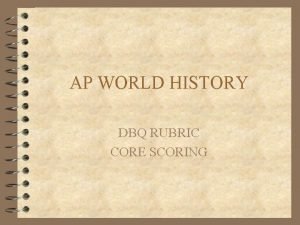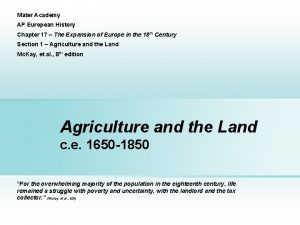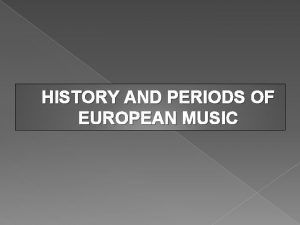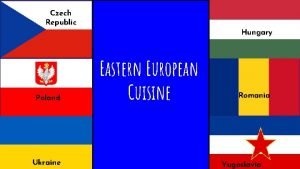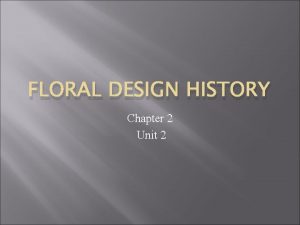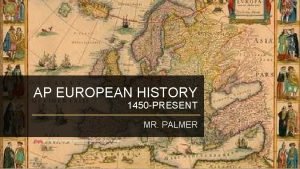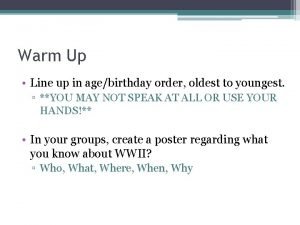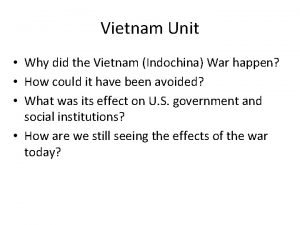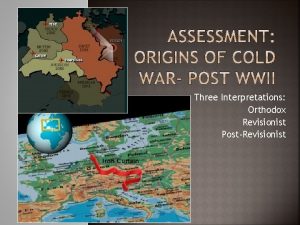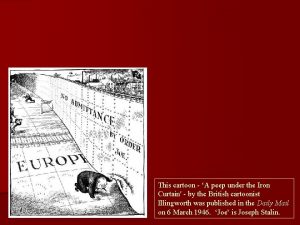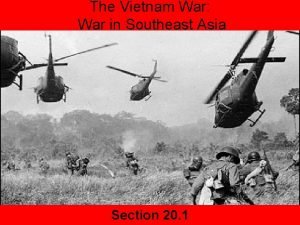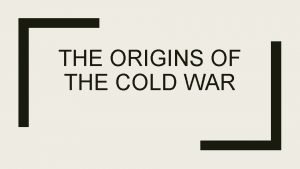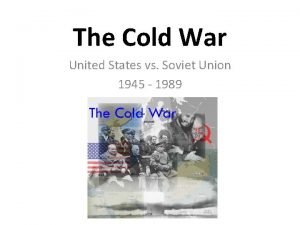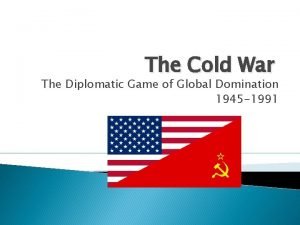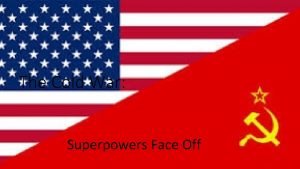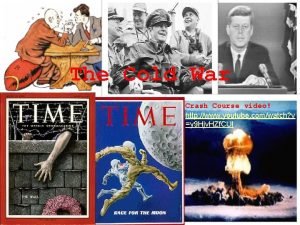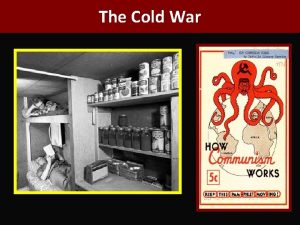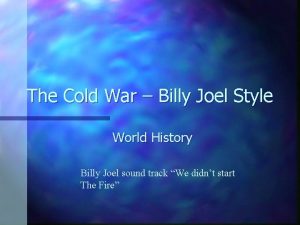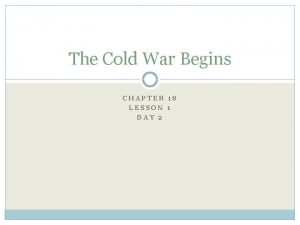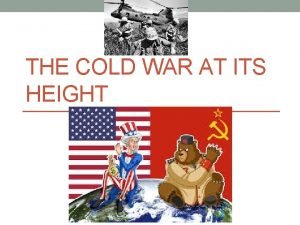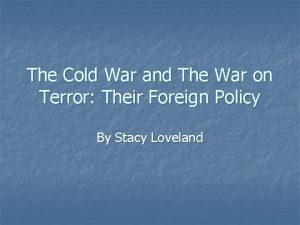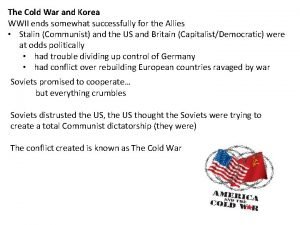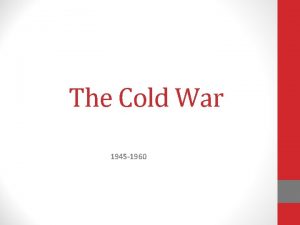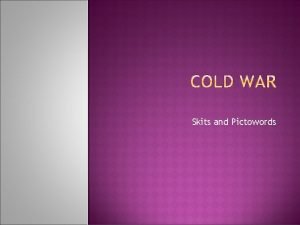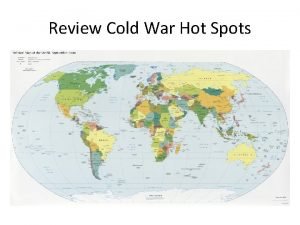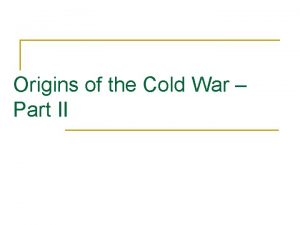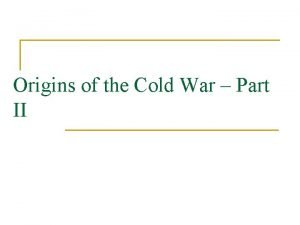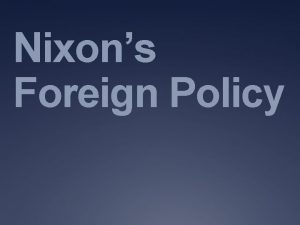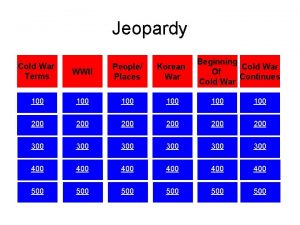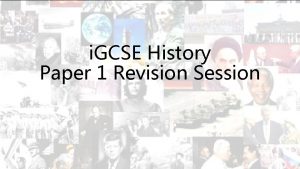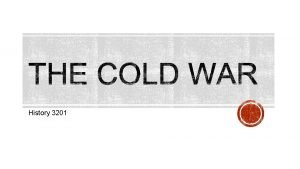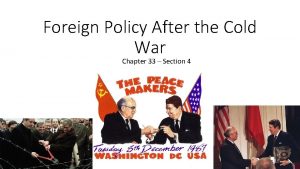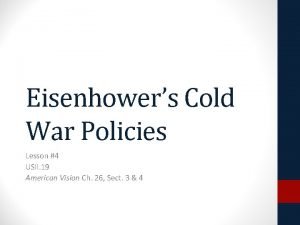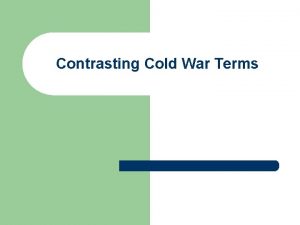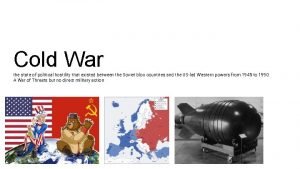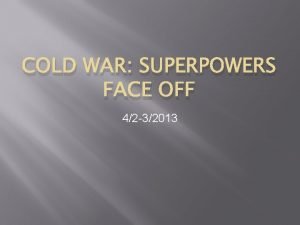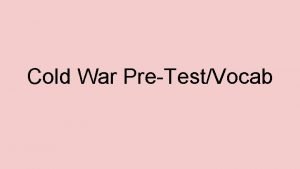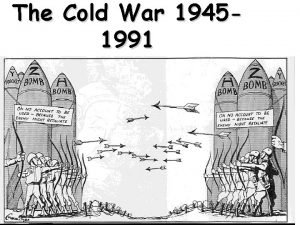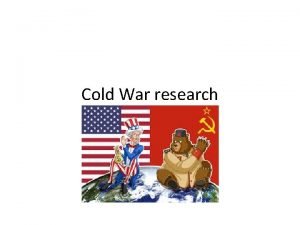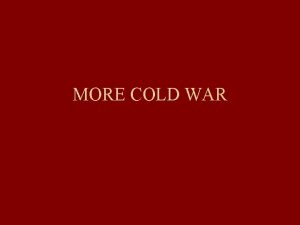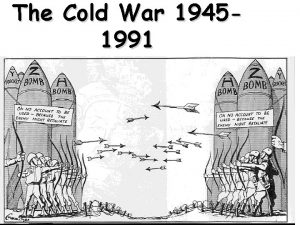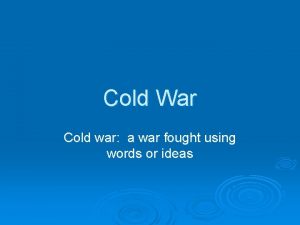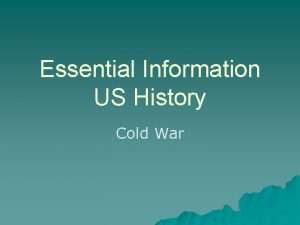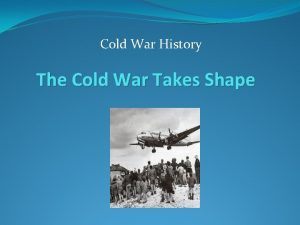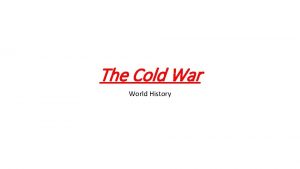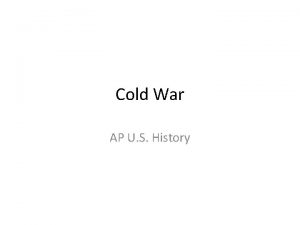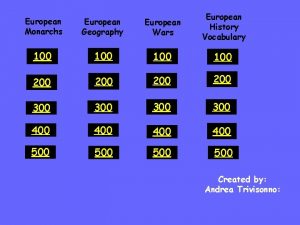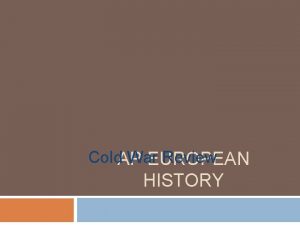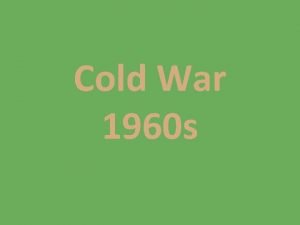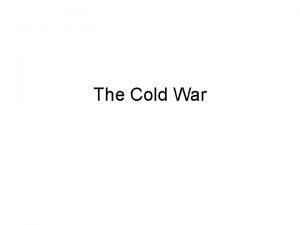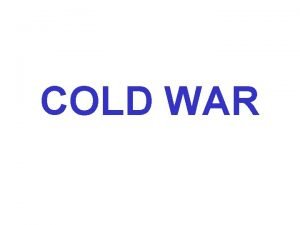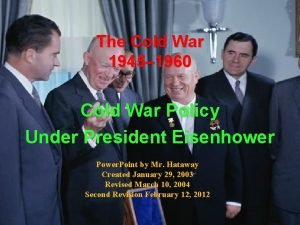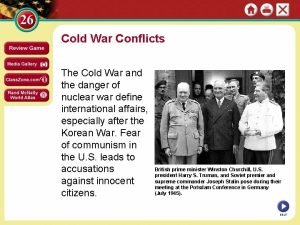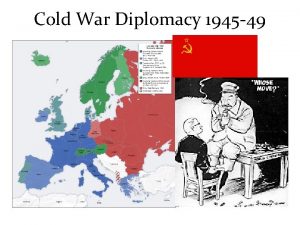Cold AP War Review EUROPEAN HISTORY The Cold



























































- Slides: 59

Cold. AP War Review EUROPEAN HISTORY

The Cold War was a diplomatic crisis which occurred between the United States (and its Western bloc) and the USSR (and its Eastern bloc). The Cold War resulted from a variety of disagreements and problems which surfaced after the end of WWII.

The “Iron Curtain” 1946: Churchill called the Soviet domination of E. Europe the “Iron Curtain. ” Stalin held a series of unfair elections and coups to install communist puppets in most of the E. European nations. Poland: 1947 Czechoslovakia: 1948 Hungary, Bulgaria, Romania, and Yugoslavia: 1946 -47

The West Takes a Stand The USSR was supporting communist rebels in Greece & Turkey. Truman asked Congress for money to aid the governments to withstand the rebels’ assaults. This became the Truman Doctrine, stating that the US would provide aid to any free nation fighting off communism. The Truman Doctrine became the basis of the US policy of “containment. ”

Military Alliances The lines between the Western Bloc and the Eastern Bloc were formally drawn with the creation of two alliances. 1949: NATO (North Atlantic Treaty Organization): designed to protect W. Europe from Communist aggression 1955: Warsaw Pact: designed to protect E. Europe from capitalist influence.

The Marshall Plan 1947 -1951: The US provided $9. 4 billion in economic assistance to Western Europe to help Europe rebuild after WWII. This aid was provided, in part, so that western European nations could resist the pull of communism.

The Division of Germany The Big three agreed at Potsdam on the division of Germany. Britain, France, the US, and the USSR each controlled one zone of occupation. The western powers wanted to see the economic and political restructuring of Germany, while the USSR wanted to maintain Germany as a communist buffer state.

Crisis in Germany Spring, 1948: The western powers introduced a new currency into their zones and requested the reunification of the zones. Stalin refused to allow a democratic Germany and withheld his zone from the German constitutional convention. The western powers decided to proceed without him and continued to help Germany construct a new constitution.

The Berlin Blockade Stalin responded to western actions by blockading the city of West Berlin. The allies responded to the blockade with a massive airlift which supplied the city for 321 days. Stalin was forced to withdraw his blockade in 1949 --a major defeat for the Soviets.

Two Germanies In response to the Berlin blockade, the western powers joined their zones into a free nation: the Federal Republic of Germany. Stalin later made his zone into the German Democratic Republic, another Soviet puppet state.

ECONOMIC DEVELOPMENT AFTER WWII Western Europe

West Germany By the 1950’s, West Germany had evolved into a stable two-party democracy [Christian Democratic Union (CDU) and Social Democratic Party (SPD)]. Konrad Adenauer (CDU) (Chancellor: 19491967) led W. Germany towards closer ties with the US and the other W. European nations.

West Germany, continued Following the death of Adenauer, Willy Brandt (SPD) took over and began a process called Ostpolitik, which meant he tried to open diplomatic contacts and with Eastern Europe. Brandt formally recognized E. Germany and accepted the post-war settlements in the east, thus easing tensions with the USSR, Poland Czechoslovakia.

Post-war Italy Following WWII, Italy adopted a new constitution which brought the Italian monarchy to an end and created a democratic republic (which still is there today). Two major parties dominated the new government: the communists (because they had been anti-fascist during the war) and the Christian Democratic Party. Italy remained in the W. European bloc.

Post-war France The 4 th French Republic was formed after WWII, but it was plagued by the frequent changes in government ministries and by factionalism. France had many small parties and so they all had to rely on multi-party coalitions to implement their policies. Women in France voted in parliamentary elections for the first time in 1946.

Fifth French Republic Using the Algerian crisis as a pretext, De. Gaulle created the 5 th French Republic in 1958, giving the French President much more power. De. Gaulle used his power to build an independent France and to try to make France somewhat independent of America.

Economic Recovery in Western Europe Marshall Plan aid was used to provide the financial underpinnings for the post-war economic recovery and expansion of W. Europe. This growth lasted until the economic downturn of the early 1970’s.

Economic Recovery For approximately a decade after the war, worker’s wages failed to keep up with economic growth. To offset the potential social problems this could have caused, most W. European governments provided social welfare protection programs for their citizens.

Post-war Great Britain The British Labor Party tried to direct national policy toward solving many problems, such as inadequate housing for workers, poor safety standards and wages in industries, and lack of security in employment. The Labor Party concentrated on many issues that had been big problems since the industrial revolution.

Britain, continued To avoid social unrest, the government enacted a variety of reforms. The British government nationalized the Bank of England, the railways, the airlines, and the coal & steel industries. The government also established old-age pensions, unemployment insurance, allowances for child-rearing, and the National Health Service.

Reforms in Europe France and West Germany also faced many of the same social and economic problems that were found in Britain. The French communist party was somewhat powerful after WWII and forced many socialist reforms. West Germany also adopted many similar reforms to bring recovery and stability after the war.

The Cost of Reform The economic cost of these social & economic reforms was long debated. Because the 1990’s process of globalization often had a negative effect for the nations of W. Europe, (with their high wages and very comprehensive social welfare programs), they often found it much harder to compete in the global marketplace. Under Margaret Thatcher, there was a significant rollback of the Br. welfare state.

Implementation of Economic Reforms 1951: Formation of the European Coal & Steel Community. Goal: to coordinate the production of coal & steel and to prevent some of the economic competition that had served as a cause for previous 20 th century wars.

Economic Reforms, cont. 1958: Formation of the European Common Market (now the European Economic Community--EC) The EC was established to eliminate custom duties among the participating nations and to establish a common tariff on imports from the rest of the world.

European Union 1991: Members of the European Union (European Parliament) signed the Maastrict treaty in 1991 in Maastrict, Netherlands. Goal: to establish a common European currency and a central banking structure by 1999. The Euro is currently in use in member nations.

Map 30– 1 THE GROWTH OF THE EUROPEAN UNION This map traces the growth of membership in the European Union from its founding in 1957 through the introduction of its newest members in 2004. Note that Turkey though having applied for membership has not yet been admitted.

The Eastern European Satellites Following WWII, the USSR set as a priority the establishment of a system of satellite states in E. Europe. The USSR created the Warsaw Pact in 1955 to establish military control of its satellites. Economic conditions remained poor in most E. European nations, due to a lack of capital for economic development.

CRISIS IN EASTERN EUROPE Examples: post WWII to Bosnian Crisis

The Soviet Union Under Khrushchev Soviet Communist leader Nikita Khrushchev wanted to keep the dominance of the Communist Party but does reform some of Stalin’s policies decentralized economic planning and removed restrictions on private cultivations of wheat The Secret Speech of 1956 – Khrushchev denounces Stalin’s policies and purges and removes Stalin supporters from the government without executing them (destalinization)

Poland 1956: Economic and political conditions similar to those found in E. Germany set off a series of strikes in Poland. The Polish government, working with the USSR, sent its troops into the streets to stop the strikers. This protest brought a slight raise in workers wages and was viewed as a success by the people, despite the bloodshed.

Hungary 1956: Inspired by the Polish revolt of 1956, Imre Nagy of Hungary encouraged a variety of reforms. Reforms included the creation of a multi-party state with Nagy as premier, a call for respect of human rights, the ending of political ties with the USSR, the release of many political prisoners, the creation of Hungary as a neutral nation, and the removal of Hungary from the Warsaw Pact.

Hungary, continued In response to Nagy’s demonstrations, the Soviets decided to make an example of Hungary to prevent it from threatening their control of their whole system of satellite states. The Soviets invaded Hungary, killing thousands and setting up a police state. Reprisals were brutal.

American-Soviet Tensions Despite a visit to the US in 1959, tension was high between the superpowers. 1959: 1960: 1961: 1962: Sputnik U-2 Incident Bay of Pigs Invasion Berlin Wall Cuban Missile Crisis

The Berlin Wall Political and Economic conditions in E. Germany and many other Eastern bloc nations remained so poor that millions were fleeing through West Berlin to freedom in western nations. The Berlin Wall was built in 1961 to stop the flow of refugees to the west. This was seen and publicized as a barbaric move and became a visible symbol of the cold war conflicts.

Detente Since the Cuban Missile Crisis had brought the superpowers so close to war, both sides decided to embrace a degree of détente, or peaceful coexistence. Missile negotiations Détente was seen as a sign of weakness in the USSR and Khruschev was ousted by 1964.

The Brezhnev Years Brezhnev replaced Khruschev in 1964 and ruled the USSR until his death in 1982. Although he did not reinstate the terror of the Stalin era, he did seek to once again strengthen the role of the Communist party bureaucracy and the KGB. Brezhnev also clamped down on reform movements in the E. European satellite states and called for a “new cold war. ”

Eastern Europe 1968: Prague Spring: led by Alexander Dubcek, this reform movement in Czechoslovakia attempted to bring about “socialism with a human face, ” while still remaining in the Soviet Bloc. Brezhnev saw this as a threat to the entire Warsaw Pact and initiated the Brezhnev Doctrine [The USSR would support with all means necessary (including military) any E. European communist state threatened by internal strife or external invasion. ] This was used as justification for the invasion of Czechoslovakia, ending reform.

The Invasion of Czechoslovakia Russian forces under the orders of Soviet premier, invade Czechoslovakia and take more liberal communist leader Alexander Dubcek out of power In the summer of 1968, Soviet tanks rolled into Czechoslovakia, ending that country’s experiment in liberalized communism

Détente with the United States Détente is the easing of strained relations between the Soviet Union and the United States, a thawing at a period roughly in the middle of the Cold War. In the Soviet Union, détente was known in Russian: loosely meaning relaxation President Richard Nixon and Brezhnev conclude agreements on trade and reduction of nuclear arms Soviets pursue activist foreign policy maneuvers in many African nations, Nicaragua, and Vietnam

Détente in the Late 70 s Under Gerald Ford, the US and USSR sign the SALT (Strategic Arms Limitation Treaty) the United States, along with the Soviet Union and other European nations, also sign Helsinki Accord recognizing the Soviet sphere of Eastern Europe as long as human rights are protected President Jimmy Carter demands the Soviets follow the Helsinki Accord, cooling relations between the countries

End of Détente The Soviet Union, wanting more of a presence in the Middle East, invades Afghanistan United States sends aid sent to Afghan rebels, which included radical Muslims The invasion fails, weakening and demoralizing Soviets Future SALT talks are abandoned The Soviet invasion of Afghanistan that was to shore up a struggling allied regime led to harsh criticisms in the west and a boycott of the 1980 Summer Olympics, which were to be held in Moscow. The 1980 American presidential election saw Ronald Reagan elected on a platform opposed to the concessions of Détente.

Communism in Poland Protest strikes led by Lech Walesa, occur across the country in response to the rise in meat prices September 1980 – Polish Communist Party replaced by independent union called Solidarity

Response to Solidarity 1981 – General Wojciech Jaruzelski becomes head of the Communist Party, declares martial law and arrests Solidarity leaders Pope John Paul II – Polish papal who was an outspoken critic of communism

President Ronald Reagan and Soviet Relations Reagan in his first term, intensifies Cold War rhetoric, increases military spending, slows arms limitations, and plans to deploy a Strategic Defense Initiative Russians in response increase military spending even though they couldn’t afford to eventually bringing the country to economic collapse

Revolution in E. Europe Reform policies of Mikhail Gorbachev prevented the USSR from interfering in E. European internal affairs. This led to a series of revolutions in 1989 in Hungary, Czechoslovakia, Bulgaria, Albania, East Germany, and Romania. These nations started on the road to democracy and market economies and faced many political and economic struggles in the 1990’s.

The Reforms of Mikhail Gorbachev Economic perestroika – or “restructuring” reduced size and importance of the centralized economic ministries advocated private ownership of property and the steering of the economy towards a free market system economic policies fail as economy remains stagnant Glasnost or openness- Gorbachev allows criticism of the government, less censorship, free expression encouraged and dissidents released from prison

The USSR Gorbachev’s policies of glastnost (opening) and perestroika (restructuring) combined with the political transformation of the Soviet satellites to create a desire for change in the Soviet population. Disasters such as the Soviet invasion of Afghanistan and the Chernobyl nuclear accident revealed the deplorable state of affairs within the nation.

East Germany A flood of refugees traveled from E. Germany to Hungary where Hungary allowed their free passage to W. Germany. The fall of the Berlin Wall in 1989 marked the end of the Communist regime that had oppressed many since 1945. 1990: Reunification of East and West Germany.

Problems in the USSR Gorbachev saw the need for change but wanted the Communist party to lead and control the changes. His economic changes were very slow and reformers, such as Boris Yeltsin, wanted him to speed up the process. 1990: The Soviet government was forced to allow the political participation of non. Communist parties.

More Problems As the political and economic structure of the USSR began to collapse, nationalist movements throughout the USSR also popped up, beginning with the declaration of independence by Lithuania. Other republics, such as Estonia, Latvia, Ukraine, Belarus, Georgia, Kazakistan, and Uzbekitan soon followed. By 1992, 17 republics had broken away.

Revolution in Russia December 1990: Gorbachev appointed a few hard-liners to government positions hoping to stop the tide of rebellion. Hard liners were very concerned about the break away republics and wanted to stop the secessionist movement. This move backfired and started a rivalry between Gorbachev and Yeltsin (a reformer and Chairman of the Russian Parliament)

The coup d’etat August 1991: While Gorbachev was on vacation, the hard-line communists staged a coup and placed him under house arrest in his summer home in the Crimea. This was done because the hard-liners feared that Gorbachev’s policies were threatening the existence of the Communist party. Yeltsin bravely stood atop a tank outside the parliament building and led the resistance, thus becoming the popular hero of the revolution.

The Coup Fails As a result of Yeltsin’s leadership and the popular support for the reform movement, the coup failed, and the hard-liners were discredited. August 1991 -December 1991: More of the Soviet republics continued to break away, further weakening the USSR. December 1991: The USSR was dissolved and Gorbachev resigned.

Problems in Russia The Commonwealth of Independent States was formed in 1992, but was ineffective and short-lived because break-away republics feared that Russia had too much power in the confederacy. The new Russian Republic faced serious political, social, and economic challenges, many of which still continue, today. The mob became very influential in Russia and many break-away republics, as well.

Russia under Yeltsin and Putin Yeltsin’s troubled reign Yeltsin supported by the West puts down Parliament protest that attempts to overthrow him new Parliament and constitution voted on in 1993 Russia at war with Islamic province of Chechnya still to this day economic downturn due to corruption by the “oligarchs”, defaults on international debts and political assassinations Yeltsin resigns in 1998 and is replaced by Vladimir Putin

Chechnya More trouble with Chechnya as Putin renews war and spawns a major act of terrorism in which Chechens take over an elementary school, take 1, 200 hostages and eventually when confronted by troops kill 330 people, mostly children Putin in response centralizes power more Russia today Putin’s Russia still more democratic than the Soviets even with his concentration of power corruption and violent crime on the rise economy stagnant, social and educational systems in decay life expectancy declining

Civil War and the Collapse of Yugoslavia Yugoslav leader Tito keeps the many different ethnic and national groups under control – his death eventually leads the country into chaos and civil war Nationalist leaders Slobodan Milosevic in Serbia and Franjo Tudjman in Croatia gain authority

Yugoslavia and Civil War 1991 – Slovenia and Croatia declare independence from Yugoslavia civil war erupts in 1992 between Serbs and Croatians Serbia accuses Croatia of fascism / while Croatia accuses Serbia of being a Stalinist regime both forces attempt to divide up Bosnia-Herzegovina Muslims in Bosnia are caught in the middle and are subject to “ethnic cleansing” by the Serbs Balkanization

The Bosnian Settlement Due to the atrocities that were being done by the Serbs, the US and other NATO nations got involved to stop the killing. This led to the US-brokered Dayton Accords of 1995 which ushered in an era of precarious peace in Bosnia. The US and UN sent peacekeepers to protect the Bosnian Muslims. War Crimes trials were held to convict those responsible for the ethnic cleansing.
 Welcome 1 unit 10 lesson 1
Welcome 1 unit 10 lesson 1 Proxy wars cold war
Proxy wars cold war Ww1 jeopardy
Ww1 jeopardy History of cold war
History of cold war European war 1
European war 1 Middle ages floral design
Middle ages floral design 1993 europa
1993 europa Colonial williamsburg floral design
Colonial williamsburg floral design Arts of emerging europe
Arts of emerging europe Dbq rubric ap world
Dbq rubric ap world Middle ages floral arrangements
Middle ages floral arrangements Ap european history chapter 17
Ap european history chapter 17 Music history periods
Music history periods Eastern european cuisine history
Eastern european cuisine history Chapter 2 history of floral design
Chapter 2 history of floral design Palmer european history
Palmer european history War at home and abroad madison
War at home and abroad madison Korean war vietnam war venn diagram
Korean war vietnam war venn diagram Sclc and sncc venn diagram
Sclc and sncc venn diagram Why was josette dugas for the war of 1812
Why was josette dugas for the war of 1812 Sein i datid
Sein i datid Contact force examples
Contact force examples Why was the civil war the first modern war
Why was the civil war the first modern war Denken simple past
Denken simple past Toward civil war lesson 3 secession and war
Toward civil war lesson 3 secession and war Chapter 30 the war to end war
Chapter 30 the war to end war Chapter 30 the war to end war
Chapter 30 the war to end war The cold war acrostic poem
The cold war acrostic poem Napalm vietnam war
Napalm vietnam war Postrevisionist
Postrevisionist Peep cartoon
Peep cartoon Operation rolling thunder cold war
Operation rolling thunder cold war What are causes of the cold war
What are causes of the cold war Who fought in the cold war
Who fought in the cold war Effects of the cold war
Effects of the cold war Superpowers cold war
Superpowers cold war Cold war crash course
Cold war crash course Characteristics of cold war
Characteristics of cold war Starkweather homicide 1958
Starkweather homicide 1958 Lesson 1 the cold war begins
Lesson 1 the cold war begins The cold war at its height
The cold war at its height Cold war who was involved
Cold war who was involved Cold war countries
Cold war countries 2 sides of cold war
2 sides of cold war Korean war summary
Korean war summary Totalitarianism pictoword
Totalitarianism pictoword Cold war hot spots
Cold war hot spots Origins of the cold war
Origins of the cold war Origins of the cold war
Origins of the cold war Nixons foreign policy
Nixons foreign policy Why did stalin want to create a “buffer zone”?
Why did stalin want to create a “buffer zone”? Agent orange and napalm
Agent orange and napalm What are satellite states cold war
What are satellite states cold war Chapter 33 section 4 foreign policy after the cold war
Chapter 33 section 4 foreign policy after the cold war Lesson 4 eisenhower's cold war policies
Lesson 4 eisenhower's cold war policies Contrasting cold war terms
Contrasting cold war terms Warsaw pact definition cold war
Warsaw pact definition cold war Chapter 17 section 1 cold war: superpowers face off answers
Chapter 17 section 1 cold war: superpowers face off answers Guided reading cold war superpowers face off
Guided reading cold war superpowers face off Pretest communism and the cold war
Pretest communism and the cold war


